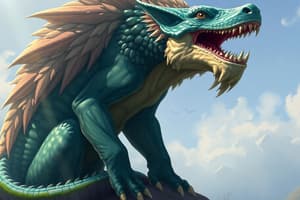Podcast
Questions and Answers
Name the 4 classifications we have learned about?
Name the 4 classifications we have learned about?
Mammals, Birds, Reptiles, Amphibians
What are cold-blooded animals also known as?
What are cold-blooded animals also known as?
Ectothermic animals
What are warm-blooded animals also known as?
What are warm-blooded animals also known as?
Endothermic animals
What are animals active during the day, night, and dusk to dawn called?
What are animals active during the day, night, and dusk to dawn called?
What are animals with a backbone and no backbone called?
What are animals with a backbone and no backbone called?
Name 2 benefits of having a backbone and no backbone?
Name 2 benefits of having a backbone and no backbone?
What is adaptation?
What is adaptation?
Name 3 animals and give an example for each animal on how they have adapted to climatic conditions?
Name 3 animals and give an example for each animal on how they have adapted to climatic conditions?
What is evolution?
What is evolution?
Why did animals evolve?
Why did animals evolve?
Study Notes
Animal Classifications
- Four animal classifications: Cold-blooded, Warm-blooded, Vertebrates, Invertebrates
- Cold-blooded animals are also known as ectotherms.
- Warm-blooded animals are also known as endotherms.
- Animals active during the day are diurnal, animals active during the night are nocturnal, and animals active during dusk to dawn are crepuscular.
- Animals with backbone are vertebrates, animals without backbone are invertebrates.
Benefits of Vertebrates and Invertebrates
- Vertebrates benefit from having a strong internal structure, which provides support and allows for movement and protection for internal organs.
- Invertebrates benefit from being able to adapt to various environments due to their small size and diverse body structures.
Adaptation and Evolution
- Adaptation is the process by which an organism changes in response to its environment to survive and thrive.
- Examples of adaptation:
- Polar bear: Thick fur and blubber to survive in cold Arctic climates
- Desert fox: Large ears to lose heat in hot desert environments
- Camel: Can store water in its hump to survive in arid environments
- Evolution is the gradual change in the genetic makeup of a species over generations.
- Evolution occurs as species adapt to changes in their environment and compete for resources.
Studying That Suits You
Use AI to generate personalized quizzes and flashcards to suit your learning preferences.
Related Documents
Description
Explore the fascinating world of animal classifications, including cold-blooded and warm-blooded creatures, vertebrates, and invertebrates. This quiz delves into their benefits, adaptations, and evolutionary processes. Test your understanding of how these classifications impact survival in various environments.




